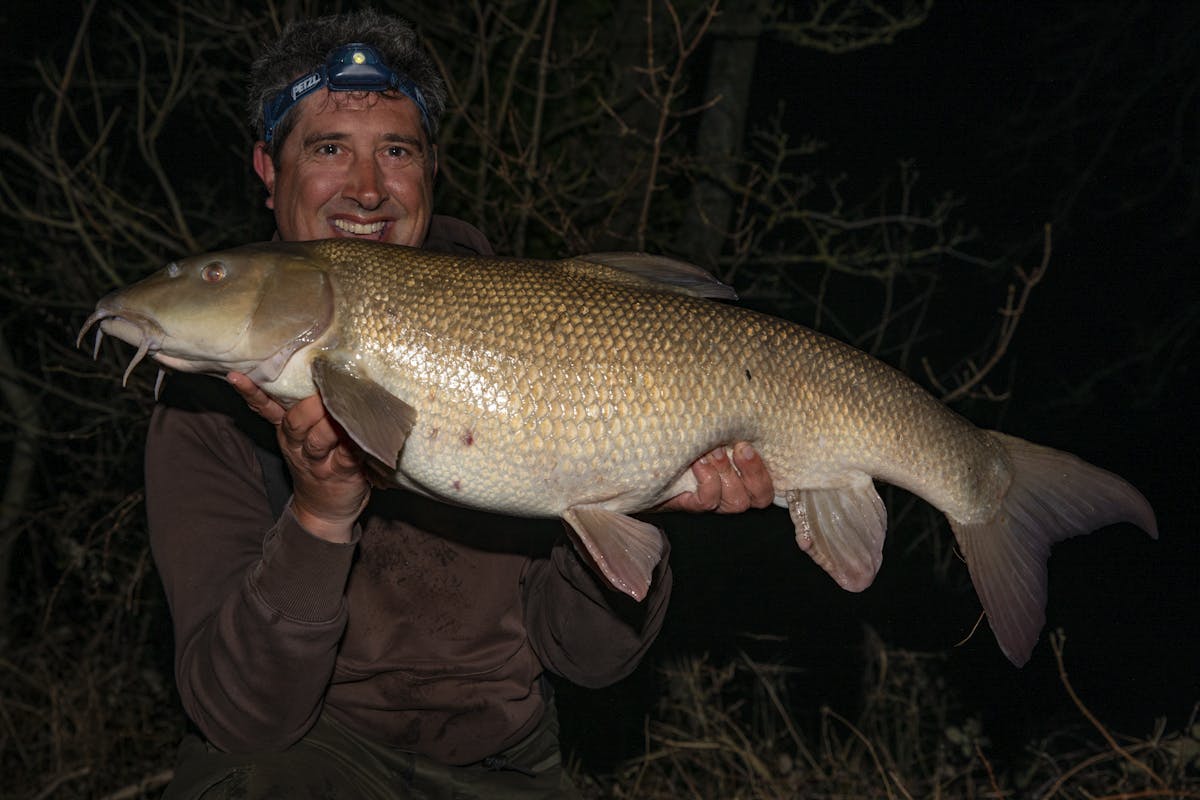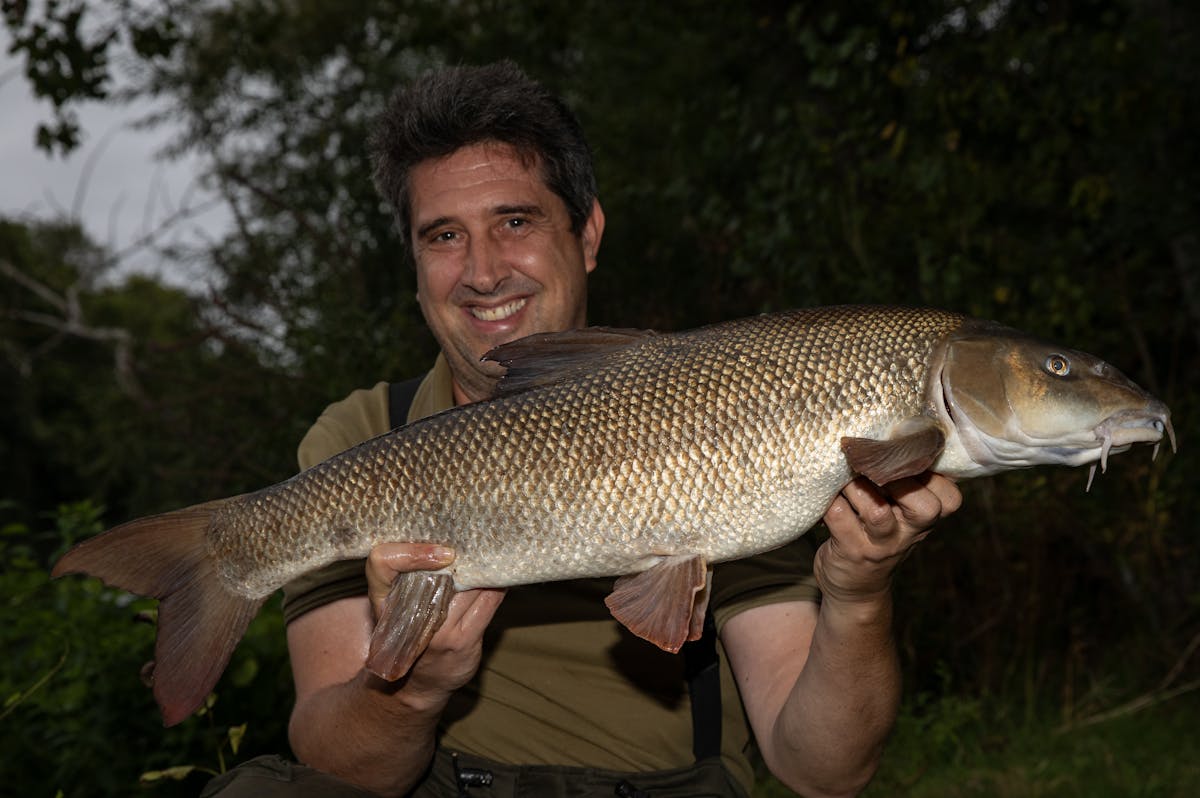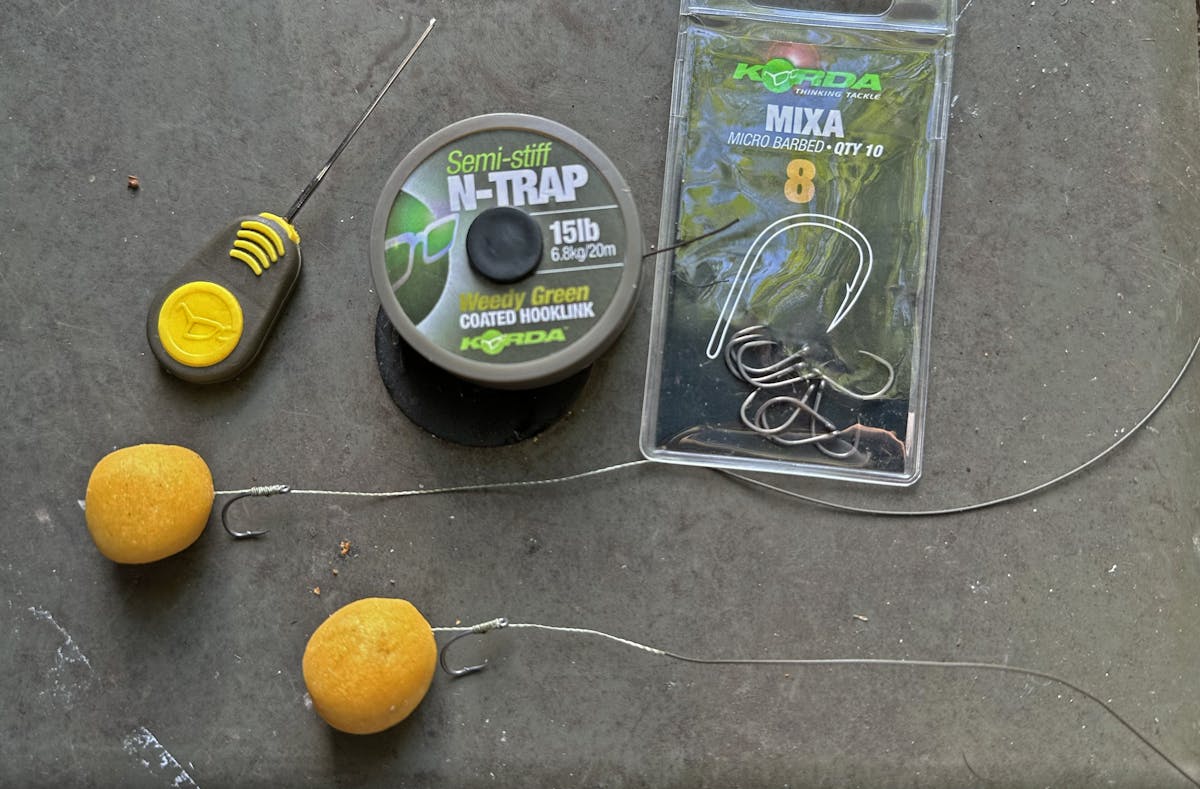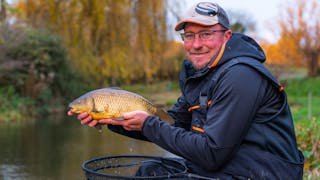
Barbel and chub fishing on the River Thames - Gary Newman
Gary Newman takes an in-depth look at how he goes about targeting big barbel and chub on the UK's best known river
Barbel fishing on the River Thames is very different to the fishing that I do on smaller rivers, which tends to be roving around with one rod for a few hours, whereas the Thames often lends itself more to overnight trips with multiple rods on buzzers.
It’s a river that I’ve been fishing for the past 20 years or so, on quite a number of different stretches throughout the lower and middle reaches, and one where I was lucky enough to catch my personal best barbel of 20lb 2oz from a couple of winters ago, and my biggest ever chub of 7lb 9oz also came from there.

The Thames definitely isn’t an easy river, and on many stretches the fishing for both the barbel and the chub can be challenging, especially during periods when the fish don’t seem to be on the feed, or are hard to find, and blanks are fairly common.
The rewards are definitely there though, as almost any stretch of the Thames is capable of throwing up huge barbel or chub, and that includes the free fishing stretches (anywhere below Staines) - even the club controlled areas are generally available on a fairly cheap, readily available tickets, and with plenty of water to go at.
The fishing on the Thames tends to vary greatly throughout the course of the season, during which time conditions vary from almost zero flow at all when water levels are low, to a raging torrent during flood conditions, and although my approach is dictated by that to some extent, the basics don’t change much.

Location is the biggest thing that you need to get right, as with the river not holding a big head of barbel and chub in general, if you aren’t on them then you won’t catch. That doesn’t necessarily mean dropping right on top of where they live, but being in areas where they will pass through regularly – I actually prefer that to trying to find and fish areas where they hold up in, especially as a lot of the action tends to come during the hours of darkness, when the fish are moving around and have left these holding areas.
Generally I’m looking for clean gravel areas, with a reasonable depth - ideally 6ft or more, but in the summer I’m happy to fish shallower spots in faster flowing water, such as weirpool run-off – and ideally some sort of depth change, whether that be a deeper hole/trough, or where the riverbed starts to shallow up downstream of a longer, deep section. During the warmer months oxygen levels also play a big part and you want a reasonable amount of flow, with weirpools being very productive at times during the summer.

Finding these areas usually starts with looking at the flow, and I look for smooth areas of water with a steady flow to indicate deeper stretches, and any sort of boiling/disturbance on the surface to give me an idea where it shallows up, or even where some sort of snag may be. Its then a case of checking whether what you are seeing and interpreting is correct – sometimes it can be deceptive and a nice smooth area has no real depth at all! – and this is usually done by casting out a heavy enough lead (you want it to go down in as straight a line as possible) and feeling it down, or more recently I’ve also been using a castable fish finder as it speeds up the process and gives a more detailed picture of what is in front of you.
Obviously, you also have to take into account river conditions and pick your swim/spots accordingly, as it’s no good trying to fish an area on the far side of the river if it is in flood and/or carrying a lot of debris (such as leaves during the autumn), so you need to adapt based on that.
When the river is in this condition, look for slacker areas – smooth water not boiling or eddying too much – close on where there is still a reasonable depth. My biggest Thames barbel came just two rod lengths out in a small slack where I could hold bottom with a 6oz lead, and literally where there was only space for one rod anyway, and over the years I’ve had other big barbel from similar spots in conditions where most people wouldn’t even bother fishing.

Water temperature, as well as river level and colour, play a big part in my decision of which species to target during the winter months, and although generally if we have a warmer spell then I target barbel, but if it goes cold I switch to chub, I’ve actually had some of my best barbel catches when the temperature has started to fall quickly – it’s as though they know a cold spell is coming and have one last feed.

Once you’ve found a likely looking area, you then need to consider your baiting approach, and unlike on some rivers, I’ve found that piling in pellets and/or groundbait is often detrimental, and in many cases will just lead to a sleepless night with lots of bream action. I’m more than happy to just fish with a PVA bag of freebies – typically my boilie mix that have been boiled as a flat ‘pancake’ and then broken up into pieces, as this allows good leak-off as it is still like a paste in the centre - or even just a single hookbait. If I do put in any other bait it tends to be catapulting in a few boilies or pieces of paste at regular intervals (every couple of hours). I’ve had plenty of success with just a single boilie on its own though, and the barbel and chub still seem to find it, but you don’t get pestered by bream – wrapping some paste around your hookbait helps with attraction/leak-off and can be good in colder water temperatures.

The type of boilies - or any other bait such as pellets or luncheon meat - that you use isn’t that important, it just needs to be something that you are confident in and know that the fish will eat if one comes across it. I personally prefer a milk protein, and make my own from scratch, including the base mix, but pretty much any meaty, fishy or creamy flavour seems to work, and it’s more down to what you have confidence in.
The size of my hookbait varies, with much larger baits of maybe 20mm, and sometimes wrapped in paste, when I’m fishing during the summer or in flood conditions and mainly targeting barbel, and wanting to avoid small fish such as chublets. In the winter in normal river conditions I tend to drop down to somewhere around 14mm – although it’s not exact as I hand roll my boilies and depends on whether barbel or chub are the main target – generally I use smaller bait for chub. In terms of the hardness of your bait, during the summer I prefer harder boilies to stop small fish picking them apart or pulling them off of the hair (small eels can be a nightmare at times), but in the winter I want them as soft as possible, but so they still stay on, as this increases the leak off of the attractors that you’re using in your boilies (a hard skin reduces that, and especially so in colder water).

When it comes to tackle on a river like the Thames, I’ve been using the 12ft 1.75lb N-Gauge Dual Tip rods, with the straight tip as I’m fishing with one or two rods on buzzers – in tighter swims or flood conditions I only ever use one rod as a second often increases your chances of the lines getting tangled and losing a fish, and if a fish is in your swim, one rod is often enough to get a bite.

These rods are coupled with the N-Gauge Specimen reel in the 6000 size – but any of the three reels in the range would do the job – and most of the time these are loaded with 30lb Korda Apex braid. The reasons for using this braid is that it is thinner than mono, even in that breaking strain, at just 0.23mm, and it means I can usually get away with using a slightly lighter lead than I could have done with a 10lb or 12lb mono. It also gives better bite indication when fishing upstream – bites are normally a sharp dropback as the fish hooks itself and moves downstream – and is pretty tough against snags, unless there are sharp rocks. Debris does stick to it more easily, but in that sort of situation when a lot is coming down the river, I’m recasting far more regularly than normal anyway.

In terms of recasting, once my rig is in position, and as long as it is holding in place and there isn’t debris building up on the line and sliding down to the lead, I’d be more than happy to leave it out until I get a bite, and that could be all night if no action occurs. I see little point in recasting just for the sake of it – I’ve had bites literally within minutes of casting out, but also 12 hours later, so it really is down to when there is a feeding fish in front of you, plus I don’t want to cause more disturbance than I need to.
My rig usually consists of a boilie on a simple hair rig, tied knotless knot style so the hair comes off the shank somewhere close to being level with the barb, and the length of that depends on whether I’m targeting barbel or chub. For chub I like to fish my hookbait very close to the bend of the hook, basically touching it, as they tend to pick baits up in their lips, and I’ve also caught plenty of barbel on this set up over the years. If I’m fishing specifically just for barbel, and in some case trying to avoid hooking chub, then I’ll opt for a longer hair with up to an inch separation (depending on bait size – more separation with bigger hookbaits).

My choice of hook has typically been the Korda Mixa pattern in a size 8 (or a size 10 in winter for chub if I’m scaling down) and I think this is hook that is often overlooked by specimen anglers, but they’re missing out as they are brilliant! They’re very sharp and the shape of the point means that they don’t easily blunt when fishing over gravel, and once they’re in they tend to stay in, and you can give the fish plenty of stick if you need to as these hooks are very strong and tend to bury themselves.

In most cases I opt for a Korda 15lb N-Trap Semi-Stiff coated braided hook link, with a couple of inches stripped back above the hook to give it a bit more movement. The length varies depending on the fishing situation, but is typically 15 to 18 inches for barbel, and 9 or 10 inches if I’m specifically targeting chub, where I want the bolt effect of the lead to come into play sooner. I don’t really like going shorter than this as you never quite know what you are casting onto, as the bottom can be quite lumpy, and I don’t want my hookbait too close to the lead, especially if any debris slides down the line to it. In floodwater conditions where a lot of rubbish is coming through I will sometimes go longer, as well as using a Marker Elastic stop knot a few feet above the lead, so the debris mainly collects around that instead.

When it comes to my lead set-up, I’m less fussy with barbel and have had success on running Original Grippa or Square Pear leads, as well as on the inline Square Pear set-up that I favour for chub – they pick up baits far more cautiously and I think that with an inline lead they get pricked by the hook more quickly. If I’m fishing in a snaggier area, especially one with a rocky bottom such as in a weir pool, then I will use a Micro Lead Clip system, set to drop the lead if it becomes stuck but not so that it comes off too easily. With barbel, I think that once they pick up the bait and get pricked by the hook then it is pretty much game over for them and the bites tend to be unmissable, unlike chub which can be far harder to hook, even when actually holding the rod.
Lead size very much depends on what I need to hold my rig in the spot that I want to fish, whilst also providing some degree of bolt/self-hooking, and on the Thames can be anything from 2oz to 10oz, depending on river conditions at the time.

How To Guides

How To – Tie A Bomb Rig
Here’s a guide on how to tie the perfect Bomb Rig

How To - Use A Speed Bander
This handy tool maximises fishing time and improves bait presentation, helping you catch

How To – Set Up An Elasticated Feeder
Here’s a step-by-step guide on how to tie the perfect elasticated Hybrid/Method Feeder

How To - Set Up An In-Line Hybrid/Method Feeder
Here’s a step by step guide showing you how to tie the perfect In-line Method/Hybrid

How To – Tie A Helicopter Rig
The Helicopter rig is a fantastic set up for natural water feeder fishing. Here's how to

How To - Tie Matt Godfrey's Free Running Feeder Rig
Matt Godfrey uses this rig in most of his natural water feeder work, here’s how to create

How To – Soak The Perfect Micro Pellets
A guide on how to prepare the perfect micro pellets every time you go fishing.

How To - Mix Paste
Paste fishing is a great method for carp, especially in warm months. Here's how to mix it

How To – Mix The Perfect Groundbait
Achieve that perfect groundbait mix for every match with this how-to guide.

How To - Use Distance Sticks
How to use Distance Sticks and accurately measure and replicate fishing spot distances.
Features

Barbel and chub fishing on the River Thames - Gary Newman
Gary explains the tactics and tackle that he uses

Become A Pellet Waggler Master
All-round expert, Steve Ringer, explores one of the most exciting and effective methods

Bomb Fishing For Carp... WITH BREAD!
How to catch more carp using one of the cheapest and simplest fishing baits out there…

Margin Mayhem
Tanks Tips for Catching big carp down the margins in the warmer months

The Big River Mission!
Matt and Tank, took to the mighty River Trent on a big-fish attack using the flat float!

Up And Down - The perfect combo attack for catching more!
Adam Rooney, explores and explains his favourite combo for a commercial bagging attack!

Feeder Fishing Secrets Revealed In "Incredible" Underwater Film
Matt Godfrey, Adam Rooney, and Steve Ringer explore feeder fishing for bream in Underwater

UK Champ Steve Ringer Tackles New Venue With Baits He's "Never Used Before!'
Steve Ringer, the current UK champion, recently fished at a Carpadrome in Belgium.

Andy Bennet's 5 Tips To Improving Your Maggot Fishing This Winter
Andy Bennett's biggest winter maggot fishing tips and tricks.

Gurus Underwater 3 – Andy Bennett and Steve Ringer Pole Fishing Secrets Revealed
Underwater 3, Andy Bennett and Steve Ringer pole fishing on the underwater cameras.
Tackle Focus

A-Class Poles
An in-depth look at all the poles within the A-Class range

N-Gauge Specimen Reels
Everything you need to know about the N-Gauge Specimen reels

N-Gauge Specimen Rods
The N-Gauge Specimen range of Dual Tip and Barbel rods

Aventus Zero900 and Zero700 Poles
The Aventus Zero700 and Zero900 pole range explained in detail

X-Change Bait Up Rods
Find out everything you need to know about the X-Change Bait Up rods

N-Gauge Poles
An extensive insight into the N-Gauge pole range.

Aventus Steve Ringer Rods
The Aventus Steve Ringer Rods are premium rods for various feeder fishing needs.

Fusion Luggage
Fusion luggage offers versatile, durable storage solutions for various fishing needs.

Guru Pole Float Range
Guru MW Pole Floats are hand-made, durable, high-quality fishing floats for various

Adjustable Rig Cases
The Adjustable Rig Cases offer durable, versatile storage for your hooklengths.
Related news

The Fishing Gurus Live Audience Podcast - Christmas Special
24.10.2025
Matt Godfrey and special guests are back for a LIVE Christmas Special!

Guru Feeder Cup 25/26
24.10.2025
An awesome series of matches that lead to one lucky winner! Pick your qualifier and enter

Kiveton Over 50s Autumn Festival 2025
27.10.2025
Find out more and get tickets for this fantastic 2-day event - 29th & 30th of October

Kiveton Silverfish Festival 2025
27.10.2025
Back this November with a Top prize up to £1500 for the winner!

